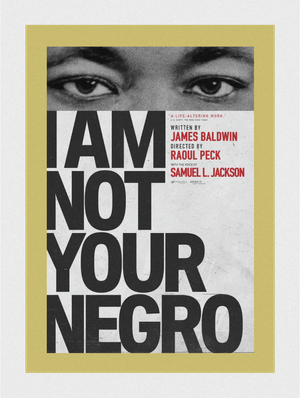Not everything that is faced can be changed, but nothing can be changed until it is faced.” - James Baldwin.
A few years ago, our local fine arts center held a screening of I Am Not Your Negro, a 2016 documentary by Raoul Peck, based on James Baldwin's unfinished manuscript, Remember this House. My partner and I attended the screening. It is not easy to describe the film. On one hand, I believe every adult in the US should see it. On the other hand, some would not watch it, and others would find it too painful.
The entirety of the film is based only on Baldwin’s words. What is not heard directly from him, via old film clips, is beautifully narrated by Samuel L. Jackson. Baldwin speaks of being a witness more than an activist. He describes the thin line that exists between the two. He was a writer who moved people with his words.
The fact that James Baldwin was born in 1924 and was a friend and contemporary of Medgar Evers, Martin Luther King, and Malcolm X in no way lessens the power of his words. They are as relevant for us today as they were in his time. As we hear Baldwin speak of the deaths of these three men, we are reminded of how much he lost and how much he risked to speak out. The director, Raoul Peck, has also interwoven clips of current police brutality and activism amongst scenes from the Civil Rights era. Baldwin’s words tell a story, but the images underpin and enlarge that story. It reminds us that we still have far to go.
This movie makes you see, makes you feel. There are scenes in the film that are disturbing, shocking, and frightening. Peck does not hold back. He wants to open your eyes, open your mind, and open your heart. He shows the face of racism both from those who perpetrate racism and those who are its victims. All through it are woven Baldwin’s powerful words.
Peck said he made this film because he felt that Baldwin was being forgotten and left behind. Peck wanted to bring Baldwin’s words back to life and keep them in front of us. He has accomplished that in a beautiful, terrible, and powerful way.
Empathy
Why was Raoul Peck’s film so effective in touching me?
Stories, when done well, can deeply touch us and even build empathy. This mechanism rests in how our bodies and our minds respond to stories. Karen Eber, in her TEDx talk, How your brain responds to stories – and why they're crucial for leaders, gives us insight into how this happens.
When you listen to a story, your entire brain starts to light up. Each of your lobes will light up as your senses and emotions are engaged. There’s this term neural-coupling, which says as the listener, your brain will light up exactly as mine as the storyteller. It mirrors this activity as if you are experiencing these things. Storytelling gives you this artificial reality.
As you listen to stories, you automatically gain empathy for the storyteller. The more empathy you experience, the more oxytocin is released in your brain. Oxytocin is the feel-good chemical and the more oxytocin you have, the more trustworthy you actually view the speaker. This is why storytelling is such a critical skill for a leader because the very act of telling a story makes people trust you more.
If I talked to you about, like, walking through the snow and with each step, the snow is crunching under my shoes, and big, wet flakes are falling on my cheeks, your brains are now lighting up as though you are walking through the snow and experiencing these things. It's why you can sit in an action movie and not be moving, but your heart is racing as though you're the star on-screen because this neural coupling has your brain lighting up as though you are having that activity.
The film I Am Not Your Negro, reminded me of many things I have not seen, still do not see, and do not recognize. I live a life of privilege; some experiences will never be mine and will be hard for me to comprehend and acknowledge. I can know them with my head, but it will forever be a challenge to find a way to know them with my heart. This film helped open my heart and enabled me to know more. It elicited powerful feelings and emotions that have stayed with me.
In reflecting on the film and the experience that day, it seems relevant to mention that something else powerful happened to me even before the film started.
Shared Experience
As I sat in the theater, with the lights up, I spent a few minutes looking around the audience. In the group were people I knew, but also many people I didn’t know. The meaning of the moment hit me. It both filled my heart and opened it to see over one thousand people from my hometown gathered for this remarkable film. All of us had come to discover and celebrate this specific story, James Baldwin’s story. We shared intent, and we shared physical space, but we shared more than that. We shared community. There was amazing solidarity and inspiration for me in the act of coming together and sharing both story and community.
What Stories Will You Tell?
Whose stories are you telling across your community? Through whose eyes do you see the story? How might you use storytelling to help groups within your community understand more deeply and see through the eyes of their neighbors?
And, in what way can you be more purposeful and more engaging before, during, and after moments of storytelling to heighten a sense of shared community?


